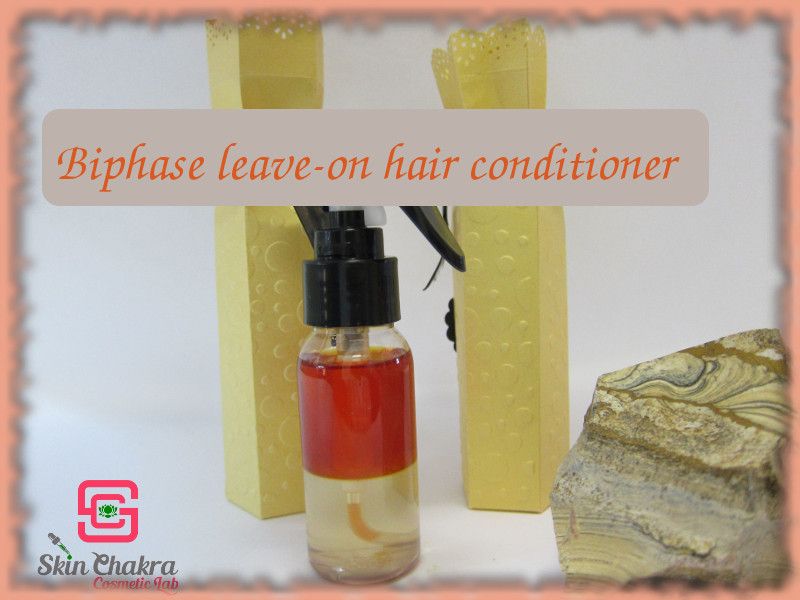
Donnerstag, 17. Januar 2019
Natural biphase leave-on conditioner
As I still had long hair, biphase leave-on conditioners were my absolute personal favourites. Basically I love biphase products and I think they are highly undervalued in "natural & organic" cosmetic community and specially among purists and minimalists who try to use as little ingredients as possible.
By making biphase products you can avoid a bunch of ingredients and some time consuming stability tests and this not only makes your life as a formulator (and manufacturer) much easier, the outcome is usually more attractive and appealing than a plain emulsion without any functional disadvantages.
For a biphase product you basically need:
- at least one oil component
- at least one hydrophilic filler/carrier
This means you need a water phase (40-60%) and an oil phase (40-60%). Of course you need to preserve and stabilize the product and make it optically appealing but all of these steps are much easier in a biphase compared to the conventional O/W or W/O emulsion.
One of the most important ingredients in a biphase product is an electrolyte to help break the temporary emulsion that is formed when you shake the biphase product before application. The electrolyte could be as basic as NaCl, the pure and plain table salt to more functional salts with additional hair & skin care properties such as Magnesium Chloride.
Usually you want to create an optical contrast between the colours of the two phases although there are many biphase products with same colour phases on the market as well.
We have shared many recipes and formulations in the past and I recommend you go and have a look at our previous tutorials for a warm-up and some theoretical background before you continue here.
Before we proceed:
I have chosen Spectrastat G2-N as the preservative system for this conditioner. This is (to this date) one of the few "natural" preservative that performs independent of the pH. This means you can easily adjust the pH of the water phase between 4-5, something impossible with most of the natural preservatives on the market.
However this preservative has some drawbacks and limitations (like every other ingredient). Spectrastat G2-N is not compatible with iron. This means it causes a colour change and a compromised performance. Well, you may not deliberately add an iron salt to a hair conditioner but be aware that many "natural" products: hydrosols, extracts and most remarkably aloe contain iron and are not compatible with this preservative. This is the reason I avoided aloe in this formulation and I chose hydrosols which were compatible with the preservative. Please check the compatibility of your hydrosols and extracts in a small experimental batch before you spoil your ingredients in a real batch. The colour change usually happend within 48 hours.
Formulation:
| Phase A | |
| Neroli hydrosol | 30,5% |
| Geranium hydrosol | 20,0% |
| Sodium lactate | 1,0% |
| Sodium PCA | 2,5% |
| Magnesium chloride | 2,0% |
| Caffein powder | 1,0% |
| Natural chelator PA-3 | 0,1% |
| Phase B | |
| Lexfeel natural | 25,0% |
| Isoamyl laurate | 2,0% |
| Passionfruit oil | 2,0% |
| Buriti oil | 3,0% |
| Olive squalane | 5,0% |
| Pracaxy oil | 1,0% |
| PCA glyceryl oleate | 1,0% |
| Amaranth CO2 extract | 1,0% |
| Fenugreek CO2 extract | 0,5% |
| Tocopherol | 0,5% |
| Rosemary CO2 extract | 0,1% |
| Antimicrobial CO2 extract | 0,1% |
| Spectrastat G2-N | 1,0% |
| Rose geranium oil | 0,3% |
| Ylang-ylang oil | 0,2% |
| Litsea cubeba oil | 0,2% |
Procedure:
1- Blend phase A and phase B in separate containers. Depending on the ambient temperature in your storage room and lab you may need to slightly heat some of the ingredients that have a melting point just around the room temperature. A water bath @ 40 oC is completely sufficient for this purpose.
2- Prepare a 10% dilution and measure the pH of the water phase. We have selected Spectrastat G2-N as the preservative system and it functions independent of pH. This means you don't need to adjust the pH according to the preservative but you need to adjust the pH for a hair conditioner. In our case, the pH was 4,5 which is absolutely suitable for a leave-on conditioner.
3- After the pH is measured and adjusted add both phases in a suitable container.
4- Enjoy the optical beauty and the functional performance of this conditioner: shake well before use and spray over damp or dry hair.
BeHappy and have fun

